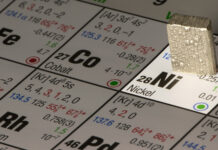
[miningmx.com] — BHP BILLITON may quit the nickel business as early as next year after selling two major nickel divisions in four months, though it still produces more than a tenth of the world’s nickel in Australia and Colombia.
BHP, which inherited much of its nickel business when it bought WMC in 2005, touts iron ore, copper and oil as the way forward, with nickel accounting for just 2% of sustainable operating earnings before interest and tax (EBIT).
“In light of what’s already been sold, you’ve got to question how committed BHP really is to nickel,” said Eagle Mining Research analyst Keith Goode.
The remaining nickel assets include a smelter and refinery along with several mines scattered across the Kambalda and Mt Keith nickel belts in Australia called Nickel West and its Cerro Matoso mining and smelting business in Colombia.
The assets are estimated to be worth $2-$4bn.
Analysts name Xstrata, Minara Resources, Norilsk Nickel and Jinchuan Group as possible suitors for all or part of the nickel operations, given each already runs integrated mining-through-refining operations similar to BHP.
While Moscow-based Norilsk has not acquired any new debt this year, it is still considering launching bonds or selling treasury shares in part to raise cash.
Jinchuan, China’s largest nickel producer and already a joint venture partner in Australian nickel mining, wants to raise its production by two-thirds within five years.
Minara, part-owned by Xstrata, this month lost out to Canada’s First Quantum Minerals, which paid $340m for BHP’s Ravensthorpe nickel project.
Questions to persist
“From a higher level, questions are likely to persist for BHP Billiton’s nickel business given its lack of materiality to the group,” Macquarie Bank, which assigns only two percent of BHP’s net present value to nickel, said in a recent client note.
Since backing out of its Gag Island nickel joint venture with Indonesia’s PT Antam Tbk 13 months ago, BHP has sent mixed signals about nickel.
In a conference call in mid-August, CEO Marius Kloppers said he believed the nickel business could be rejigged to address the advent of cheaper Chinese nickel pig iron production, but warned of nickel price ceilings hindering profit growth.
“These developments have changed the dynamics of the nickel market a little, and probably mean that prices will be capped more on the upside, because there is a large amount of ready capacity, which can kick in when demand increases,” he said.
BHP’s sale of its Ravensthorpe laterite nickel project to First Quantum followed that in July of its Australian Yabulu refinery to a local mining magnate.
“If nickel is off BHP’s radar, they will act swiftly to let it go,” said a source with knowledge of the sale process ahead of the Ravensthorpe sale. “I wouldn’t expect it to drag on beyond 2010.”
BHP has shuttered mines in Australia’s Leinster nickel belt and continues to buy other mining companies’ ores to keep its Nickel West smelting and refining arm at maximum run rates.
Dozens of jobs were cut in August from the nearby Mt Keith operations – home to the world’s largest open cut nickel mine – to ensure its economic viability. In January, BHP laid off 300 workers at the same mine.
Sales volumes from the Australian Nickel West division fell 14% to 88,200 tonnes last year. The Cerro Matoso mine and smelter-refinery complex in Colombia churned out a further 50,500 tonnes in 2008/09.
Royal Bank of Scotland values BHP’s entire stainless steel division – nickel is bought by stainless steel producers for alloying – at $0.87 per share. That’s third from the bottom for the world’s largest diversified miner before energy coal and diamonds, and far from the $9.20 a share assigned to iron ore.
“It’s not like BHP Billiton pursued these assets, many of which came with the acquisition of WMC, where the prize was the copper and uranium at Olympic Dam, not nickel,” said a source familiar with BHP’s nickel divisions.
More nickel on the way
The world is awash with nickel and the substitution material pig iron with the promise of more to come. First Quantum has vowed to glean 39,000 tonnes of nickel a year from Ravensthorpe within 18 months, contributing three percent more metal to the global supply pool. But that’s just the start.
TD Newcrest counts 14 nickel projects either built or in development that are scheduled to start in 2010-13, including Ravensthorpe, that could add 512,000 tonnes of new nickel per year – more than a third of current global annual consumption.
Unlike Ravensthorpe, which cost $2.2bn and was shut eight months after starting, BHP is unlikely to just idle what’s left in Australia, given a string of supply pacts it holds with regional miners for turning their ore into metal.
One way out would be to sell the mines separately and retain the downstream processing apparatus, regarded as highly profitable enterprises, say analysts.
“The concentrator in Kambalda is a cash machine for BHP that’s always made money,” said Eagle Mining’s Goode.
Nickel prices have recovered since the trough of the financial crisis — up 30% this year – along with most industrial metals, though forecasters are mixed on future pricing given the promise of more supply hitting the market.










